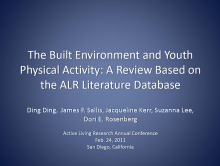We are pleased to announce an exciting new alliance between Active Living Research and GP RED to co-host and coordinate...
The Built Environment and Youth Physical Activity: A Review Based on the Active Living Research Literature Database

Presentation at the 2011 Active Living Research Annual Conference
Access the ALR Literature Database.
Background:
In the last decade, research from public health, urban planning, recreation and sport science fields has produced substantial evidence for the associations between the built environment and physical activity. Several review papers have summarized findings, however few have been systematic, quantitative, and focused on objectively measured built environment.
Objectives:
To systematically and quantitatively summarize published literature on objectively measured built/social environment variables and youth physical activity using the Active Living Research (ALR) Literature Database.
Methods:
The ALR literature database is a publicly accessible online database that codes study characteristics and detailed results of published papers in built environment and physical activity/obesity/ sedentary behavior. From 2002, researchers at ALR have conducted biannual literature searches through PubMed, Web of Science and SPORTDiscus, using systematically developed and expert validated search protocols. Observational studies examining associations between the built/social environment and physical activity/weight outcome/sedentary behavior, and related environmental intervention studies were included in the ALR database. Trained research assistants coded design features, methods, and results of identified papers using a detailed protocol. For quality control, another research assistant and a supervisor checked each coding and invited an author of the paper to approve. If corrections are requested by authors, their suggestions are compared with database protocol and decisions for correction are made accordingly.
The current review was conducted using the ALR database as a searching tool. Inclusion criteria for papers were: 1) observational studies published before 2010; 2) study sample included youth (18 years or younger); 3) dependent variables included physical activity; 4) independent variables included objectively measured built/social environment; 5) test statistics for associations between dependent and independent variables were provided and significance could be determined.
Design features of published papers were summarized (prospective, cross-sectional), along with sample size, geographic location, and environmental measures (objective, self-report with reliability/validity, self-report without reliability/validity). Results from studies were categorized based on physical activity measures (objective vs. perceived). Results were coded as “+” if significant association was in the expected direction, “-” if significant association was not in the expected direction, and “0” if no significant association was found. Numbers of “+,” “-,” and “0” were summed for each environmental variable-physical activity association reported.
Results:
Based on inclusion criteria, 130 papers were identified. Eight frequently-studied and objectively measured built environment variables were reviewed: recreational facilities, incivility/disorder, land use mix, population density, street connectivity, vegetation, walking/biking facilities, and walkability. Two social environment variables were crime and traffic safety. Across all built/social environment variables, more associations were found with reported physical activity than objectively measured physical activity outcome (44% vs. 21% of results coded “+”). With objectively measured physical activity, vegetation had the most consistent support (34% of results coded “+”). With perceived physical activity outcomes, street connectivity had the most consistent support (51% of results were coded “+”). Crime, traffic safety, and street connectivity had the most inconsistent associations with objectively measured physical activity among youth (14-43% of results coded “-”).
Conclusions:
Associations between the built/social environment and youth physical activity were generally inconsistent. Most variables were significantly related to youth physical activity in less than half of the reported tests. Additional analyses are needed to determine if methodological factors account for some of the inconsistencies. Environmental variables were more consistently associated with perceived than objectively measured physical activity. The ALR literature database can be used for conducting systematic reviews on the built environment and physical activity.
Support:
Robert Wood Johnson Foundation's Active Living Research program
Related Tools & Resources
STAY UP TO DATE
RECENTLY ADDED TOOLS & RESOURCES
MOVE! A BLOG ABOUT ACTIVE LIVING
The "Active Living Conference" aims to break down research and practice silos and...







